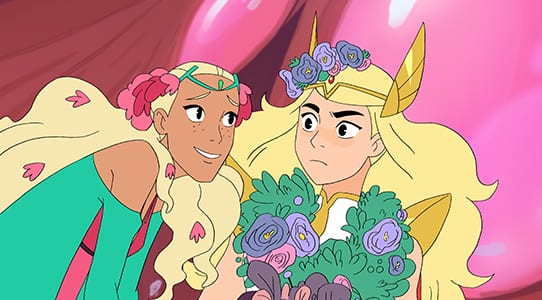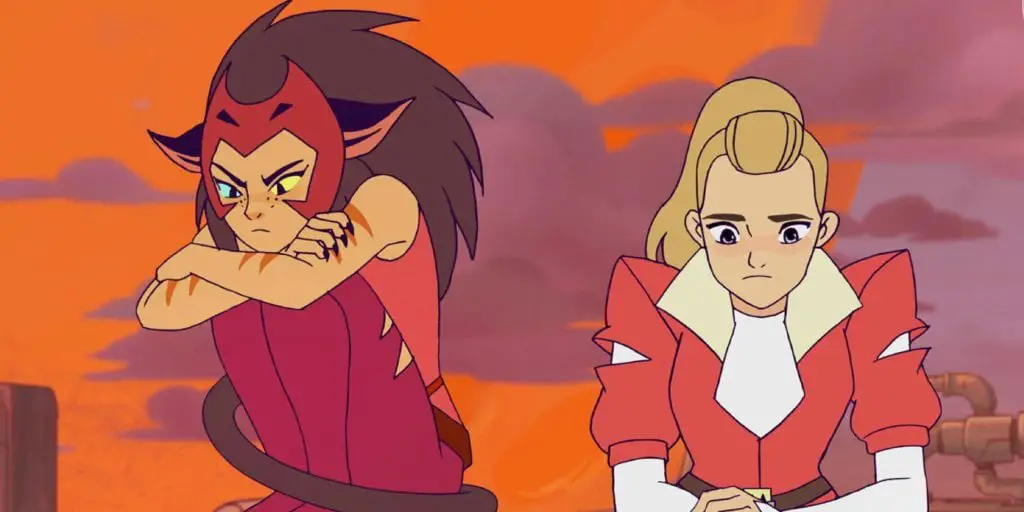Say one thing for She-Ra, it has a pretty terrific cast of characters. Some certainly succeed more than others (there’s a reason Sea Hawk has a season 2 episode openly questioning whether he’s cool or not), but overall the cast succeeds in whatever Noelle Stevenson and her crew want to do with them. And for good reason. The cast is varied, fun, visually interesting, and deftly layered in a way that both kids and adults can recognize and appreciate. It’s easy to find the character you latch on to, whether it’s Adora’s brave hero jock or Entrapta’s tech genius or yes, Sea Hawk’s glorious glam.
She-Ra does a solid job fleshing out just about everyone, even when you don’t necessarily need it. Do Shadow Weaver or Hordak need to be more than stock villain archetypes? Potentially, and we’ll see in the future, but generally you don’t need to make more of them than your common antagonist. She-Ra goes a step beyond.
Despite the numerous differences between these characters, and the many reasons they succeed owed to these differences, there’s a common thread running beneath the surface of the show that connects them. Yeah, my title gives it away.
Expectations is a bit of a vague word. Much like the characters themselves, She-Ra uses different expectations in different ways to create different responses from its characters. Whether it’s a magical destiny, ruling a kingdom, living up to a parent’s expectations, or even just the idea of living up to the expectations of your archetype, She-Ra loves to play with expectations. Naturally, of course. This is a princess story. You can’t tell a good princess story without a healthy focus on expectations.
She-Ra most certainly does just that.
The most obvious example, of courses, presents itself through Adora. No, not just through her She-Ra identity, either. The show first presents Adora to us as a promising Horde cadet. With said promise immediately comes Shadow Weaver’s expectations based on it. The 11th episode of the first season, “Promise,” gives us a glimpse of Adora’s youth and the way Shadow Weaver piled a significant burden on Adora’s shoulders. Add in the way the Horde fosters a survival-of-the-fittest atmosphere among its troops and Adora’s developmental years were defined by the need to live up to the expectations for her.
Then when she becomes She-Ra, she takes the burdens of the She-Ra destiny on her shoulders, which drives the majority of her character growth moving forward. Adora constantly tries to live up to everyone’s expectations for her alter ego. Anything resembling failure, no matter how minor, affects her deeply. Much of her lifestyle in the Horde, spent living up to the example Shadow Weaver, transfers to her mindset after leaving them. The princesses expect big things from her. Adora dedicates her life to not disappointing them.
When she can’t heal Perfuma’s forest, it affects her. The same thing happens with Glimmer’s infliction later in the season. Season 2 sees her frustrated at her inability to master her weapon. Time and again we see how Adora defines her life by everyone’s expectations for She-Ra. She’s the poster girl of how a person can define their life by everyone else’s expectations and take them as their own.

The show plays with this idea for just about every princess.
Some feel the expectations, some do the expecting. Glimmer creates immense expectations for herself both as a part of the rebellion against the Horde and also to live up to the example set by her parents. These are very much self-setting examples no one holds her to besides Glimmer herself. This doesn’t change the constant pressure Glimmer feels to succeed and the criticism she puts herself through when she fails.
Mermista responds to the pressure and expectations of ruling her kingdom through feigned indifference. Frosta feels pressure to prove herself as a ruler despite her young age, and in the episode “Princess Prom” overcompensates to be what people expect of a ruler, to the point of taking offense at Adora’s accidental insults. When she joins the rebellion proper in season 2, she also overcompensates as a fighter to prove herself and live up to the expectations the other princesses live by.
Perfuma serves as an example of someone who creates expectations. When She-Ra comes to help her, she immediately expects Adora to live up to every She-Ra legend. When she obviously can’t, having been She-Ra for like a day at that point, it does a number on Adora’s confidence. Perfuma doesn’t mean anything by it. She had no way of knowing. Still, she does create unfair expectations for Adora.
On the other side of things, we have Catra. Catra adds an interesting dynamic to this conversation. She’s fueled by growing up with almost a lack of expectations. To be sure, she felt the same pressure to conform to the Horde that every other cadet does. However, Shadow Weaver wrote Catra off very early and expected nothing but failure from her. It is this lack of expectations and the mental abuse it created, alongside Shadow Weaver’s more direct physical abuse, that shaped Catra into the person she becomes.
Season 1 ends with Catra using her experience to supplant Shadow Weaver. Ultimately it is Shadow Weaver’s lack of expectations that causes her to underestimate Catra and fall. She gets a measure of revenge, however hollow, on her abuser.
Then the switch flips. Catra takes her abuser’s place and with this new importance comes the expectations she never dealt with before. Now Hordak expects her to win his war. It’s interesting how Catra turns to Shadow Weaver in this situation. She does so out of her own expectations. Despite all the abuse, she still views Shadow Weaver as a mother figure. Catra still seeks validation as a child would from a parent. Her visits to Shadow Weaver’s prison cell are motivated by the expectation that her mother will finally admit she did well and was wrong to expect so little of her.
This contrast between Adora and Catra is played very well and is one of the main reasons She-Ra is such a good show. One had the world of expected of her and motivates herself through these expectations. The other had no expectations and motivates herself to prove people wrong. It’s far from the only thematic connection between Adora and Catra, but it’s one of the better ones.

Season 2 even introduced the idea of expectations to Bow’s storyline. We find out in the season finale about Bow’s dads and the expectations they have for his future. As historians, they expect Bow to follow in their footsteps. They pushed him towards their career since he was a little kid playing pretend. It gets so bad that when Bow goes off to join the Princess Rebellion, he lies and tells his parents he’s at an academy. The burden of his parents’ expectations was so great he didn’t even consider telling them the truth while he could potentially die at war.
Thankfully this has a happy ending. Bow tells the truth, his dads accept him, everyone’s happy.
Now, again, this is nothing special to She-Ra or even to children’s animation. Expectations play a vital role in the development of all children. They grow with their family and friends influencing their futures. Some grow up with everyone expecting them to take one path. Others develop their own interests and expectations for themselves. Then you have those for who their parents expect nothing, which no less influences them.
You see this in plenty of children’s media, or really any story that includes children. The most serious dramas include it. Paige Jennings can’t help but be influenced by her parents on The Americans, and the Stark kids grow up knowing they’ll have to fulfill society’s expectations for them in A Song of Ice and Fire. Steven Universe’s titular character is defined by the expectations the Crystal Gems have for him to succeed his mother’s legacy. On Adventure Time, Marceline’s relationship with her father is entirely about what he is, what she should be, and whether they can have a relationship despite failing each of their expectations for each other.
Where She-Ra stands out is the way it blends the idea of childhood expectations throughout so many of its characters and plot points. It’s really central to how both develop. The main character conflict of the show basically revolves around Adora fulfilling her potential as She-Ra. Her main antagonist is Catra, who desperately seeks validation of her talent from someone. Things will continue to develop as they do, and as their relationships with the expectations-laden princesses develop.
And really, through each of these characters She-Ra tackles a different idea of how expectations play into the maturation process of children. Whether it’s parental, self-imposed, professional, personal, having to do with legacy, or nonexistent, you get a view of the many ways expectations can burden someone. It makes for the varied, interesting cast which serves She-Ra so well.
Now fans have their own expectations for the future of this show. I feel confident we won’t be disappointed.

